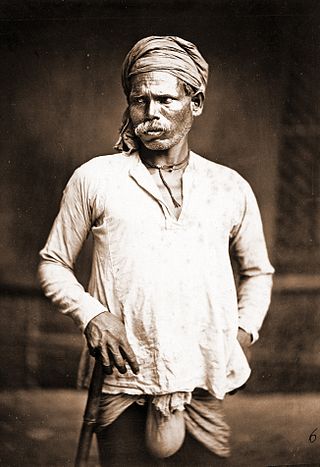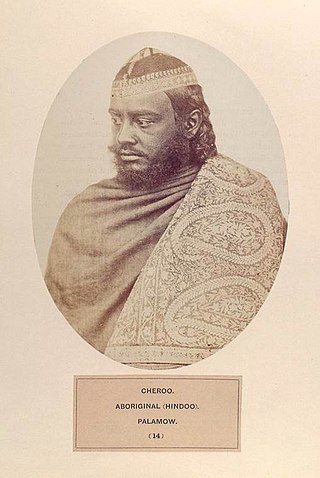Related Research Articles

The Adivasi are heterogeneous tribal groups across the Indian subcontinent. The term is a Sanskrit word coined in the 1930s by political activists to give the tribal people an indigenous identity by claiming an indigenous origin. The term is also used for ethnic minorities, such as Chakmas of Bangladesh, Bhumiputara Khasas of Nepal, and Vedda of Sri Lanka. The Constitution of India does not use the word Adivasi, instead referring to Scheduled Tribes and Janjati. The government of India does not officially recognise tribes as indigenous people. The country ratified the International Labour Organization (ILO) Convention 107 on Indigenous and Tribal Peoples of the United Nations (1957) and refused to sign the ILO Convention 169. Most of these groups are included in the Scheduled Tribe category under constitutional provisions in India.
The Other Backward Class (OBC) is a collective term used by the Government of India to classify castes that are educationally or socially backward. It is one of several official classifications of the population of India, along with general castes, Scheduled Castes and Scheduled Tribes (SCs and STs). The OBCs were found to comprise 52% of the country's population by the Mandal Commission report of 1980 and were determined to be 41% in 2006 when the National Sample Survey Organisation took place. There is substantial debate over the exact number of OBCs in India; it is generally estimated to be sizable, but many believe that it is higher than the figures quoted by either the Mandal Commission or the National Sample Survey.

The Dom, also known as Domra, Domba, Domaka, Dombara and Dombari, are castes, or groups, scattered across India. Dom were a caste of drummer. According to Tantra scriptures, the Dom were engaged in the occupations of singing and playing music. Historically, they were considered an untouchable caste called the Dalits and their traditional occupation was the disposal and cremation of dead bodies. They are in the list of Scheduled caste for Reservation in India in the Indian states of Uttar Pradesh, Bihar, Odisha, Andhra Pradesh, Jharkhand and West Bengal.

Chamar is a Dalit community classified as a Scheduled Caste under modern India's system of affirmative action. They are found throughout the Indian subcontinent, mainly in the northern states of India and in Pakistan and Nepal.

Lohar is considered to be a caste among Hindus and a clan among Muslims and Sikhs in the Indian states of Uttar Pradesh and Jharkhand, and in Nepal. They form traditionally artisanal castes. Writers of the Raj period often used the term Lohar as a synonym for blacksmith, although there are other traditional smiting communities, such as the Ramgarhia and Sikligar, and numerous non-traditional communities, including the Kayastha, Rajput and Brahmin.

Teli is a caste traditionally occupied in the oil pressing and trade in India, Nepal and Pakistan. Members may be either Hindu or Muslim; Muslim Teli are called Roshandaar or Teli Malik.
The Mallaah are the traditional boatmen and fishermen tribes or communities found in North India, East India, Northeastern India and Pakistan. A significant number of Mallah are also found in Nepal and Bangladesh. In the Indian state of Bihar, the term Nishad includes the Mallah and refers to communities whose traditional occupation centred on rivers.
Jatav , also known as Jatava/Jatan/ Jatua/Jhusia /Jataau/Jatiya, is an Indian community that are considered to be a subcaste of the Chamar caste, who are classified as a Scheduled Caste under modern India's system of positive discrimination.

The Nishad are a Hindu caste, found in the Indian states of Bihar and Uttar Pradesh.
Kushwaha is a community of the Indo-Gangetic Plain that has traditionally been involved in agriculture, including beekeeping. The term has been used to represent different sub-castes of the Kachhis, Kachhvahas, Koeris and Muraos. Under the Indian governments system of positive discrimination, the Kushwahas are classified as a "Backward" or Other backward class. The Kushwaha had worshipped Shiva and Shakta, but beginning in the 20th century, they claim descent from the Suryavansh (Solar) dynasty via Kusha, one of the twin sons of Rama and Sita. At present, it is a broad community formed by coming together of several caste groups with similar occupational backgrounds and socio-economic status, who, over the time, started inter-marrying among themselves and created all India caste network for caste solidarity. The communities which merged into this caste cluster includes Kachhi, Kachhwaha, Kushwaha, Mali, Marrar, Saini, Sonkar, Murai, Shakya, Maurya, Koeri and Panara.
The Dhanka are a tribe or caste of India who believe themselves to be aboriginal, although they are unable to assert from whence they came. They are found in Rajasthan, Haryana, Uttar Pradesh,Gujarat, Maharashtra, Chhattisgarh and Madhya Pradesh they are no relation with dhanuk kurmi. They are historically neither Hindu nor Muslim and their occupations have changed over time, as circumstances have dictated for survival. Although similar groups in India are often referred to as adivasi, the Dhanka generally reject this term.
Yadav, Jadam, or Jadav refers to a grouping of traditionally non-elite, peasant-pastoral communities or castes in India that since the 19th and 20th centuries have claimed descent from the mythological king Yadu as a part of a movement of social and political resurgence. The term Yadav now covers many traditional peasant-pastoral castes such as Ahirs of the Hindi belt and the Gavli of Maharashtra.
The Kewat, also spelled Kevat, is a Hindu caste, found in the states of Rajasthan, Madhya Pradesh, Chhattisgarh, Odisha, Bihar and Uttar Pradesh in India. They are the traditional boatmen of northern India, and also in neighbouring country Nepal.

The Chero is a caste found in the states of Bihar, Jharkhand and Uttar Pradesh in India.

The Tadvi Bhil is a tribal community found in the states of Maharashtra, Gujarat, Madhya Pradesh and Rajasthan in India. They are from the larger Bhil ethnic group, and are a clan of it. They use the surname Tadvi or sometimes the name of their Kul or Gan; the Dhankas of Gujarat and Maharashtra use Tadvi or Tetariya.

Musahar or Mushahar are a Dalit community found in the eastern Gangetic plain and the Terai. They are also known as Rishidev, Sada, Manjhi, Banbasi. The other names of the Musahar are Bhuiyan and Rajawar. there are many who are still forced to do this work due to destitution and poverty.

The Bhuiyan or Bhuiya are an indigenous community found in the Indian states of Bihar, Jharkhand, Madhya Pradesh, Odisha, Uttar Pradesh and West Bengal. They are not only geographically disparate but also have many cultural variations and subgroups.
The Paswan, also known as Dusadh, are a Dalit community from eastern India. They are found mainly in the states of Bihar, Uttar Pradesh and Jharkhand. The Urdu word Paswan means bodyguard or "one who defends". The origin of the word, per the belief of the community, lies in their participation in the battle against Siraj-ud-daulah, the Nawab of Bengal at the behest of British East India Company, after which they were rewarded with the post of Chowkidars and lathi wielding tax collector for the Zamindars. They follow certain rituals such as walking on fire to assert their valour.
Mahto or Mahato is a surname used by several castes and communities in the states of Bihar, Jharkhand, West Bengal, Uttar Pradesh and Odisha in India. Mahato is also a popular surname in Nepal. In the zamindari villages, "Mahto" was a title given to the headman of a village ward. The mahto's duties were to maintain peace in his area, and collect revenue for the zamindar. In Chotanagpur plateau region of Jharkhand, including in the Oraon tribal society, Mahato was historically a title of the village chief. In Bihar, the surname Mahto is primarily used by people belonging to Kushwaha caste. While in Jharkhand, it is a term most often associated with Koeri and Kurmi caste.
Bari or Baridar are a Hindu caste mostly living in Northern India.
References
- ↑ Peter Berger; Frank Heidemann (2013). The Modern Anthropology of India: Ethnography, Themes and Theory. Routledge. p. 33. ISBN 978-1134061112. Archived from the original on 7 February 2023. Retrieved 11 January 2021.
- ↑ Kumar, Ashwani (2008). Community Warriors: State, Peasants and Caste Armies in Bihar. Anthem Press. pp. 34–38. ISBN 978-1-84331-709-8. Archived from the original on 7 February 2023. Retrieved 11 January 2021.
- ↑ "Renu's caste, not development, into play". Times of India. 31 October 2015. Archived from the original on 16 June 2022. Retrieved 16 June 2022.
- ↑ "Bihar Elections: For votes, netas remember influential writer 'Renu', target his caste members". Firstpost. November 2015. Archived from the original on 21 November 2022. Retrieved 16 June 2022.
- ↑ "Bihar: Nitish Kumar is Trying to Consolidate the Luv-Kush-Dhanuk Axis to Expand Social Base". News18. 30 January 2021. Archived from the original on 13 April 2021. Retrieved 11 April 2021.
- ↑ "Nitish Kumar's 'Triveni Sangh' of Backward Castes May Threaten BJP's Monopoly in 2024 Polls". The Wire. Retrieved 13 April 2023.
- ↑ Moodie, Megan (2015). We Were Adivasis: Aspiration in an Indian Scheduled Tribe. University of Chicago Press. p. 49. ISBN 978-0-22625-304-6. Archived from the original on 7 February 2023. Retrieved 23 September 2020.
- ↑ Debnath, Debashis (June 1995). "Hierarchies Within Hierarchy: Some Observations on Caste System in Rajasthan". Indian Anthropologist. 25 (1): 23–30. JSTOR 41919761.
- ↑ Badri Narayan (2012). Women Heroes and Dalit Assertion in North India: Culture, Identity and Politics. SAGE. p. 46. ISBN 9780761935377. Archived from the original on 7 February 2023. Retrieved 10 December 2020.
- ↑ Moodie, Megan (2015). We Were Adivasis: Aspiration in an Indian Scheduled Tribe. University of Chicago Press. pp. 51–53. ISBN 978-0-22625-304-6. Archived from the original on 7 February 2023. Retrieved 10 December 2020.
- ↑ Moodie, Megan (2015). We Were Adivasis: Aspiration in an Indian Scheduled Tribe. University of Chicago Press. pp. 51–53. ISBN 978-0-22625-304-6. Archived from the original on 7 February 2023. Retrieved 10 December 2020.
- ↑ Moodie, Megan (2015). We Were Adivasis: Aspiration in an Indian Scheduled Tribe. University of Chicago Press. pp. 51–53. ISBN 978-0-22625-304-6. Archived from the original on 7 February 2023. Retrieved 10 December 2020.
- ↑ Jaffrelot, Christophe (2003). India's silent revolution: the rise of the lower castes in North India. London: C. Hurst & Co. p. 356. ISBN 978-1-85065-670-8. Archived from the original on 7 February 2023. Retrieved 6 June 2019.
- ↑ Faisal, Aziz (2004). "Agricultural Labourers in Patna - Gaya Region During the 19th Century". Proceedings of the Indian History Congress. 65: 477–483. JSTOR 44144762.
- ↑ "Scheduled Caste of Haryana". haryanascbc.gov.in. Archived from the original on 1 December 2020. Retrieved 19 December 2020.
- ↑ "A-10 Individual Scheduled Caste Primary Census Abstract Data and its Appendix – Uttar Pradesh". Registrar General & Census Commissioner, India. Archived from the original on 31 July 2018. Retrieved 6 February 2017.
- ↑ Chawla, Janet, ed. (2006). Birth and Birthgivers: The Power Behind the Shame. Har-Anand Publications. pp. 215–216. ISBN 978-8-12410-938-0. Archived from the original on 7 February 2023. Retrieved 23 September 2020.
- ↑ Pinto, Sarah (2008). Where There is No Midwife: Birth and Loss in Rural India. Berghahn. pp. 47–48. ISBN 978-1-84545-310-7. Archived from the original on 7 February 2023. Retrieved 23 September 2020.
- ↑ Population Monograph of Nepal, Volume II
- ↑ "2011 Nepal Census, District Level Detail Report" (PDF). Archived from the original (PDF) on 14 March 2023. Retrieved 7 April 2023.